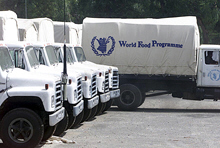
Typical street scene in Santa Ana, El Salvador. (Photo: iStock)
IMF Survey: IMF Moves to Clarify Aid Role
July 20, 2007
- IMF to encourage best use of aid
- IMF Executive Board endorses proposals
- Proposals to be integrated into IMF operational guidelines
The IMF, under scrutiny from critics and its own official watchdog over its approach to use of aid in low-income countries, is taking steps to clarify its role in advising members in the face of high and volatile aid inflows.

Relief trucks in Pakistan: evaluation saw scope for clearer guidance on IMF role in assisting financial aid use, absorption (photo: Zainal abd Halim/Reuters)
Low-income countries
At issue is the need to achieve higher levels of economic growth to reduce grinding poverty in many parts of the world while avoiding destabilizing lurches in the economy triggered by sudden inflows of aid that can cause inflation, economic bottlenecks, and exchange rate volatility which could make the poor even worse off.
The IMF's Executive Board met on July 6 to consider how the 185-member institution can promote the effective and sustainable use of aid and endorsed a number of recommendations about how to make maximum and best use of such aid.
The discussion was based on two sets of staff papers, published on July 19—one on overall program design issues (Aid Inflows—The Role of the Fund and Operational Issues for Program Design) and the other on fiscal policy issues (Fiscal Policy Response to Scaled-Up Aid). The outcome of this discussion will be integrated with related work in the Fund, such as last year's update of the debt-sustainability framework, to present a comprehensive operational framework for guiding the Fund's role in low-income countries.
Unpredictable aid flows
The international community has committed to support low-income countries in their efforts to meet the Millennium Development Goals (MDGs) by scaling up aid and improving aid delivery. Although official development assistance to low-income countries fell slightly in 2006 compared with the previous year, aid from "emerging donors" and other private flows, particularly from health funds, are on the rise (see Where's the Money?).
External assistance can offer additional resources for countries to pursue development goals, but can also be unpredictable and can create challenges for macroeconomic management, including if aid volumes were to increase sharply.
The IMF plays an important role by assisting countries in creating and maintaining an enabling macroeconomic environment for the effective use of aid. Helping countries design policy frameworks that support sustained growth and poverty reduction while maintaining macroeconomic stability and debt sustainability is an integral part of the Fund's Medium-Term Strategy (MTS).
In particular, the MTS emphasizes the IMF's work in advising low-income countries on appropriate macroeconomic policies in the face of increased but volatile aid inflows. IMF advice promotes the full use of aid in a multi-year context, while smoothing public spending from year-to year. In countries where macroeconomic stability is not yet at hand and reserves are low, a prudent strategy involves initially saving part of higher aid, to build up an adequate reserve buffer which can be drawn down when aid falls short of expectations.
Response to concerns
The recent Board discussion responded in part to concerns raised by the IMF's Independent Evaluation Office (IEO) about the IMF's role in Aid to Sub-Saharan Africa. Its report, released in February this year, noted that there was scope for clearer guidance on a number of issues such as aid projection, accommodation of additional aid flows, and the examination of alternative scenarios in assessing the amount of aid that can be absorbed effectively.
The discussion focused on the operational implications of scaling up aid for IMF advice and program design. Some key recommendations endorsed by the Board were:
• IMF-supported policy programs should support the full and effective use of aid, over time, in line with the country's capacity and development needs, while maintaining macroeconomic stability.
• For the effective use of aid, increases in aid-based budgetary spending need to be closely coordinated with monetary and exchange rate policies.
• IMF staff should be available to assist country authorities in preparing alternative macroeconomic scenarios based on scaling up of aid.
• Expenditure plans should be formulated in the context of a medium-term fiscal framework. A smooth expenditure path will allow countries to deal better with aid volatility and uncertainty while ensuring that all spending programs are adequately funded.
• Wage bill ceilings in IMF-supported programs should be used only in exceptional cases, and be flexible to accommodate additional aid flows to key development sectors.
• Strengthening public financial management (PFM) systems is essential for improving the efficiency of government spending.
• Improving domestic revenue mobilization is key to reducing long-term reliance on aid.
• Program documents should provide clear explanations of program design.
These and other recommendations are discussed in more detail in two articles based on the two sets of staff papers on the use of aid prepared for the Board discussion.
Jan Kees Martijn is a Deputy Division Chief in the IMF's Policy Development and Review Department and Shamsuddin Tareq is a Deputy Division Chief in the Fiscal Affairs Department.


